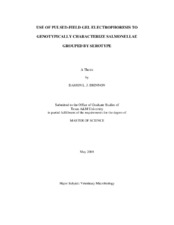| dc.contributor.advisor | Scanlan, Charles M. | |
| dc.contributor.advisor | Harvey, Roger B. | |
| dc.creator | Drinnon, Damon L. J. | |
| dc.date.accessioned | 2005-08-29T14:35:00Z | |
| dc.date.available | 2005-08-29T14:35:00Z | |
| dc.date.created | 2003-05 | |
| dc.date.issued | 2005-08-29 | |
| dc.identifier.uri | https://hdl.handle.net/1969.1/2185 | |
| dc.description.abstract | The prevention and control of salmonellae in commercial swine operations are becoming increasingly important. The current approach focuses on identifying sources and/or origins of salmonellae contamination before swine are processed for human consumption. The objective of the current study was to assess strain variability among salmonellae grouped by serotype and to determine common origins of contamination (farm or slaughter plant). Salmonellae were previously collected from swine at slaughter, serotyped by the National Veterinary Services Laboratory and stored at - 70??C. Pulsed-field gel electrophoresis (PFGE) was performed to genotypically characterize serotypic isolates using restriction endonuclease XbaI. Dendrogram comparisons were also used to assess genotypic similarity when multiple genotypes existed. This study found PFGE to be more discriminatory than serotyping indicating that multiple genotypic strains existed among selected serotypes. On the basis of PFGE results alone, origins of contamination could not be determined in this study. It is suggested by the author, that origins of contamination could be further defined pending future research, in which in-depth longitudinal studies are included. When used as an adjunct to conventional typing methods, PFGE may prove to be a substantial subtyping system in epidemiologic investigations to identify point-of-entry contaminants to the food chain. | en |
| dc.format.extent | 1572020 bytes | en |
| dc.format.medium | electronic | en |
| dc.format.mimetype | application/pdf | |
| dc.language.iso | en_US | |
| dc.publisher | Texas A&M University | |
| dc.subject | salmonellae | en |
| dc.subject | pulsed-field gel electrophoresis | en |
| dc.subject | porcine | en |
| dc.title | Use of pulsed-field gel electrophoresis to genotypically characterize salmonellae grouped by serotype | en |
| dc.type | Book | en |
| dc.type | Thesis | en |
| thesis.degree.department | Veterinary Pathobiology | en |
| thesis.degree.discipline | Veterinary Microbiology | en |
| thesis.degree.grantor | Texas A&M University | en |
| thesis.degree.name | Master of Science | en |
| thesis.degree.level | Masters | en |
| dc.contributor.committeeMember | Tizard, Ian R. | |
| dc.contributor.committeeMember | Hume, Michael E. | |
| dc.contributor.committeeMember | Simpson, Russell B. | |
| dc.type.genre | Electronic Thesis | en |
| dc.type.material | text | en |
| dc.format.digitalOrigin | born digital | en |


